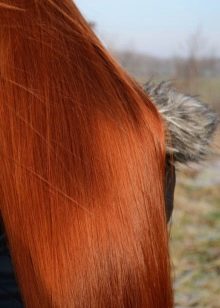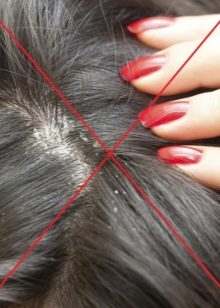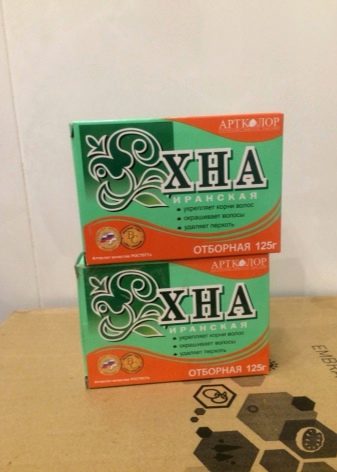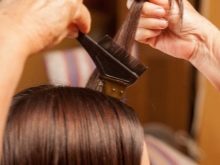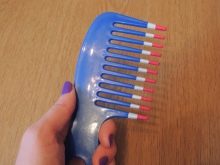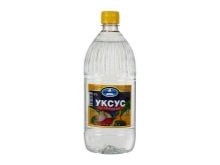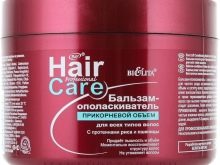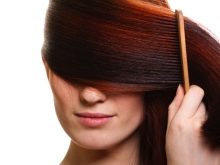We all want to look beautiful and young, no matter how old we are - 20 or 60. Modern technology allows a woman to always be young and well-groomed. Unfortunately, a large number of chemicals in cosmetics often leads to allergies and the deterioration of our skin and hair.
Why do you need it?
A few decades ago, no one could have imagined that a stinging brunette could become a blonde or a red-haired beauty. Some women paint their hair constantly and do not notice much harm from chemical dyes. Yes, they see a thinning hair, a slight loss, but they usually attribute it all to age, nutrition and stress.
However, there are those who over time appear more significant problems: dandruff, hair loss and deterioration of their appearance. There are allergies, which the first time can not tolerate the chemical elements in the paint.
Then the ladies begin to think about dyeing hair with natural substances, and henna comes to the rescue. Depending on the original hair color, whether the hair is natural or dyed, how long was the last chemical dyeing, you can easily choose a new shade, while maintaining healthy curls.
Advantages and disadvantages
When dyeing hair with henna there is a huge amount of advantages, because it is a natural product. Consider the merits in more detail.
- Henna perfectly envelops and protects hair from the sun, drying out, and salt water.
- Perfectly fights dandruff almost after the first use, because the antiseptic substances contained in its composition regulate the microflora of the skin.
- Helps with hair loss, as it contains aromatic oils and tannins that strengthen the hair follicle.
- It is an excellent tool for oily hair. Dries the roots, so that the hair does not become greasy and look very neat.
- Strengthens the hair structure by filling stratified scales, which makes it more elastic and resilient. Hair due to this turn out to be more voluminous and alive.
- Paints curls with natural substances without the use of aggressive chemicals, including ammonia.
- There are no contraindications to the use of henna in pregnant women and adolescents. There is only a very small percentage of women with allergies.
- Perfectly fills gray hair.
- It allows you to achieve bright and saturated colors, which can not always be achieved using artificial dyes.
Nevertheless, with all the pros, there are also disadvantages that you need to know before using this natural remedy.
- It is difficult to independently analyze your hair in order to find the exposure time and get the desired color. The result is affected by the condition of the hair, their naturalness or color, how much time has passed since the last dyeing, the amount of gray hair, and several other significant factors.
- Despite the naturalness, there is an allergy to the components that make up the henna.
- If you dyed your hair and you didn’t like it, it will be very difficult to wash off the color.
- It is not recommended to dye hair with henna after a perm. Components included in the composition of the product can lead to the alignment of curls, and not always uniform. Moreover, and so dry hair will be even drier.
- When pregnancy is necessary to be careful - although the paint does not affect the health of the mother and baby, due to a shift in the hormonal background, it may not take, or you will get the wrong shade. In this case, you should try to paint one strand, and if the result is satisfactory, dye all the hair already.
Henna selection
Most often, the "guests" on the shelves of our stores are Iranian, Indian and Chinese henna. They differ in the composition and percentage of henna oils and active substances, as well as in different colors obtained during dyeing.
- Iranian Henna is most common. Dyes hair in copper and gold shades. Its disadvantage is that it dries the strands strongly. Contains a large amount of tannins.
- Indian - This is the most noble look. It is very rare to find in ordinary cosmetic stores. More often it is sold in Indian stores, boutiques of natural cosmetics and on the Internet. Such henna is very nutritious, dries hair less, and colors it in red shades.
- Chinese it is quite simple to find a variety, but because of our associations to the word “Chinese”, it is more often sold as Iranian. Therefore, when buying, be careful.
How to get different shades?
To get the desired color, you first need to select the country of origin. It depends on what shades you prefer.
The basic rule for obtaining a good shade is: the longer you hold, the richer and darker the color will be.
You should also take into account the fact that maintaining the paint on light and dark hair the same time, you get a different result, because initially there were different conditions and hair color. The same will happen if you keep it the same time on natural and dyed hair.
For example, if the hair is blond, and you want to get a light reddish shade, you first need to prepare a decoction of chamomile and they already dilute henna. Keep on blond hair for 5 minutes, then rinse. To obtain a bright red tint exposure time should be increased. It is better to orient the hairdresser in time, because you need to take into account several facts, but a layman will not be able to do it competently.
In addition, at home you need to carefully try staining on light and blond curls. At short-term keeping of the dye there is a risk to get a faded color with a yellow or green shimmer.
On dark hair, depending on the exposure time, you can get red and chestnut-red shades.
Also keep in mind that girls of autumn color type with chestnut curls will look more natural after dyeing and will be able to paint over strands more evenly than blondes with light skin type and light eyes. Brunettes will get a more uniform color.
How to dye your hair?
Henna is usually sold in tightly closed packaging. It is usually green powder if it is supplied without additives.
Dilute the product is very hot, but not boiling water to the consistency of thick cream. The mixture should not flow, but the spoon should not stand in it. Color after contact with water should change to red (ideally) or to dark red.
Apply immediately after cooling, slightly warm. Optionally, to moisturize and nourish hair, you can add just before dyeing one egg or a tablespoon of oil, for example, olive oil. So strands and color, and get a nourishing and moisturizing mask. To obtain shine, you can add a tablespoon of vinegar or lemon juice when painting.
Coloring is carried out, as well as usual paint, from roots. First we apply the mixture on the occipital part, then on the temporal areas, and then on the remaining area. After distribution on the roots, we coat the strands in the same order, carefully controlling them so as not to miss any areas. Having finished the application, it is best to comb a plastic comb with wide teeth, for uniform coloring.Metal combs, as, however, and bowls for dilution of paint from the same material can not be used. The metal will react with the paint, and staining will not occur or the color may differ significantly from the plan.
This natural dye is applied with a brush, as with conventional chemical staining. Apply the mixture should be only in gloves, otherwise the effect after dyeing will be seen not only on the head. It’s not for nothing that in India henna draws on his hands, and the resulting images are held for 3 weeks.
Be sure to wrap hair with polyethylene after applying the entire mixture, you can wind a towel on top. This will help create a thermal effect for the onset of the necessary reaction. Hold the tool correctly, as recommended by the hairdresser. Usually, to obtain a rich color, they keep from 30 minutes to several hours (when dyeing dark hair).
For blond hair, to get a red shade, you need an exposure of 40 minutes, for dark - 50.
Aftercare
Rinse the henna with water and vinegar to stop the chemical reactions taking place. You will need to add one tablespoon of vinegar per liter of water. Shampoo to wash your hair directly after painting is not worth it, it will be enough hair balm. After staining, it is advisable not to wash your hair for the first 3-4 days, as the henna will still feed the bulbs.
It is also not recommended to do styling during this period, use irons and curling irons, foams and varnishes. It is worth giving hen time to heal the strands. If after this time constantly doing vinegar rinsing after shampooing, the hair will shine and look healthier, and its color will become richer, and it will last longer.
In addition, you can buy for treatment and strengthen hair colorless henna. There are a lot of options in the store now. Recently, henna with different shades has appeared, and you should be careful when buying it. Often, the manufacturer adds paint and cunning, that there are only natural ingredients, so it is recommended to carefully read the composition.
However, if you “tasted it” and were able to pick up the desired shade of henna for yourself, saw its firming and healing properties, you will never refuse this natural and wonderful natural dye. And your choice will always be in favor of natural ingredients with a healing and restorative effect. Which, in turn, will allow you to have luxurious and thick curls for a very long time.
On the other benefits of red henna for hair girls can learn from the video below.



